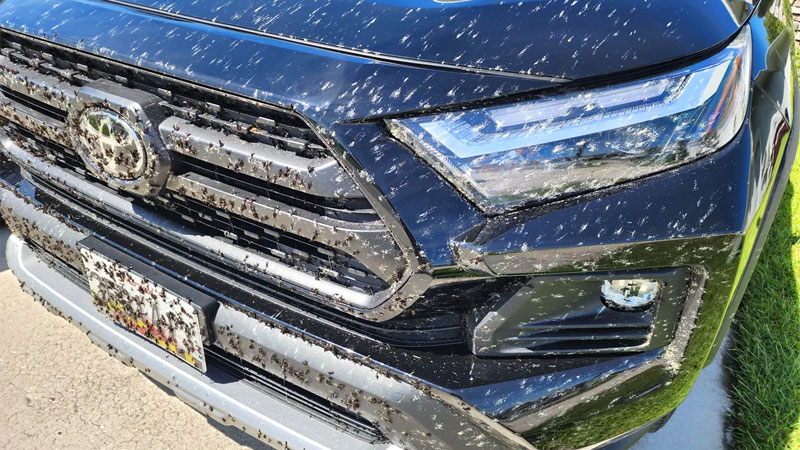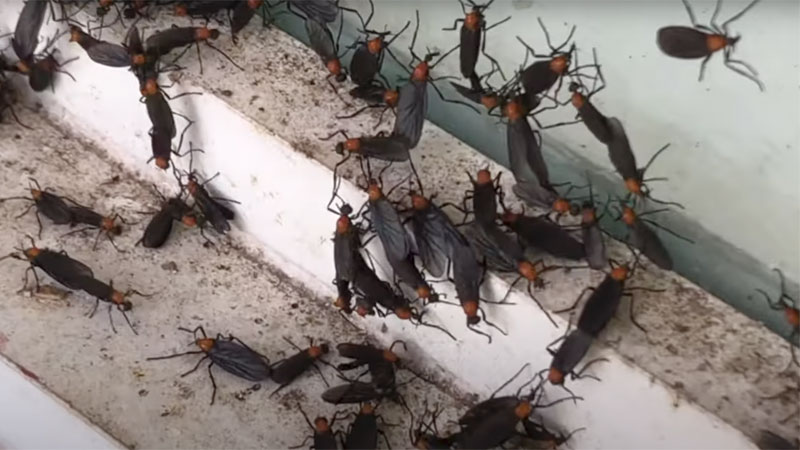Every spring and autumn, southerners begin looking to the skies with dread. But it’s not some large bird they’re watching for, it’s the lovebug.
These little bugs are black with a red thorax and an insatiable sexual appetite that causes entire swarms to hover along highways and invade homes. They squish easily, and their bodies are acidic enough that it can damage paint. In fact, the swarms can become so bad that cars have to pull over and wait for the bugs to pass by.
But just what are these little bugs and what can you do about them?
Getting to Know Lovebugs

Lovebugs have worked hard to earn their name. These march flies have earned a sordid array of nicknames for their mating habits, including the double-headed bug and honeymoon fly. Officially, they’re Plecia nearctica.
These annoyingly affectionate critters can be found all along the Gulf coast from Texas to Florida. However, they’ve been spotted as far north as South Carolina. Swarms can number literally in the millions, making them a frustrating pest problem.
See Also: What Do Baby Boxelder Bugs Look Like?
What Are Lovebugs Attracted To?
These critters find a lot of things interesting: bright colors, exhaust fumes from cars or lawnmowers, fresh paint, and any other source of carbon or methane fumes.
They associate these gasses with rotting matter, which is the perfect place for laying eggs. The larvae feed off of this matter, which makes them somewhat beneficial. Of course, this is easy to forget during the height of bug season. Adult love bugs are attracted to flowers and have a diet of mostly nectar.
The Notorious Public Displays of Affection
For whatever reason, adult lovebugs have never heard of getting a room. Instead, the males will wait for the females to emerge from their pupae and immediately mate with them.
Mating flies will dock back-to-back and can even hover in place while mating. The male dies immediately after the 2-3 day mating period, and female lovebugs die after laying her fertilized eggs. As a result, the lovebug mating season puts the 1960s to shame while covering every surface in thirsty bugs and dead bodies.
Do Lovebugs Die if Pulled Apart?
Lovebugs take their mating ritual very seriously, so much so that their genitals become locked together. Pulling them apart actually tears the genitals off, killing them.
If these bugs weren’t considered such a nuisance, their brief, literally inseparable adult lives might almost be considered romantic.
Getting Rid of Lovebugs
Mother Nature has gone to great lengths to provide some natural population control through parasitic fungi and natural predators, but this isn’t enough to prevent swarms from appearing twice per year.
As a result, you may find you have to take matters into your own hands.
Read Also: How to Get Rid of Boxelder Bugs
In the Home
During their mating season, it’s not unusual to suffer a lovebug infestation in the home. Making sure your windows are screened and caulking any gaps in the windows and door frames can go a long way towards keeping pests out. However, when lovebugs are in love, opening your door for even a second can result in dozens getting in.
Like other flying insects including hoverflies, lovebugs don’t like too much airflow, so having a ceiling fan turned to high or oscillating fans will often discourage them from wanting enter or to stick around. Unlike flies, they actually know how to use an open window once they know they’re not welcome.
You’ll also need to be careful not to squish them while they’re indoors. Their acidic bodies will leave some pretty nasty stains on any light colored surfaces. The bug residue may also attract other unwanted pests.
Read Also: Can Stink Bugs Jump?
In the Yard
Tall grass and fallen leaves are primary draws for lovebugs, who use these conditions to shelter and feed their offspring. Keeping the lawn mowed and removing any leaves or other biological matter goes a long way towards prevention.
Of course, having a compost pile means these annoying insects will still want to hang around. A good natural remedy for this is to keep your compost in a sealable container (be sure to vent it occasionally!).
Surround it with strong-smelling plants such as ornamental onions, citrus, citronella, lemongrass, or peppermint plants (to name a few) so the scent of organic matter is masked.
Also, don’t leave your lawn mower or other lawn equipment idling. The fumes will only attract more lovebugs.
How to Remove Lovebugs From Your Car

Treating your car to a good waxing before bug season begins will help keep the lovebugs from being able to hold on when the car moves. It can also make cleaning any splatters easier.
Said splatters can usually be cleaned by spraying water on the splatters and wiping them away with a dryer sheet.
Owning an electric car or one with low emissions with a darker or muted paint job is especially useful, as the bugs are less likely to chase your car in the first place.
On Building Exteriors
When it comes to building exteriors, one of the best options is a good wash. There are many great brands of pressure washer out there. Pick one with an extension wand, fill it with warm water and a decent detergent, then spray away.
You can use chemical insecticides, but the force of a power washer with the right nozzle tip can kill and wash away the dead lovebugs effortlessly. Even better, a good cleaning solution can protect your paint from the acidic nature of the bug guts and clean the dirt off in the process.
How to Kill Lovebugs
While essentially harmless, these critters can become quite annoying and even cause minor damage, so sometimes it’s better to do a little extermination to keep the population down.
Indoors, the easiest method is to simply vacuum up any that are hanging around the house and dispose of the bag afterwards.
Outdoors, you can attract robins or quail, both of which feed on lovebugs. You may also see an infestation of spiders appear in your yard as well, since they love to snack on these acidic pests.
Read Also: How to Get Rid of Water Bugs
How to Keep Lovebugs Away
There are a few ways to repel lovebugs that have proven effective.
While having darker colors can help, you’re probably not going to want to paint your house, your car, and change your wardrobe just to deter a seasonal nuisance. Instead, try making your own lovebug repellent.
Personal Repellent Lotion
A few essential oils not only smell great, they can keep lovebugs (and sweat bees) away. The exact ratio is up to you, but generally a good lotion will include 3% each of peppermint and citronella, as well as 4% turmeric.
The other 90% can be lotion, water, baby oil, or whatever else you prefer.
Simple Repellent Spray
One of the easiest repellents uses only three ingredients. Simply mix 3 tablespoons each of mouthwash and citrus-scented dish liquid with a cup of water. Spray this on surfaces where the lovebugs like to gather, such the porch, patio, and along walls.
Citronella
Finally, you can’t go wrong with citronella or other citrus-scented candles. These tend to be quite effective in repelling a whole host of unwanted bugs while smelling great.
- How to Get Rid of Hawks - March 8, 2024
- How to Get Rid of Pill Bugs (Rolly Pollies) - March 1, 2024
- How to Get Rid of Groundhogs (Woodchucks) - February 5, 2024


 Just tell me how to get rid of ’em.
Just tell me how to get rid of ’em.
I used the mouthwash, liquid citrus soap, and water but it didn’t work. The lovebugs were not affected by the spray mixture at all.
Thanks anyway
I have been using this formula for years, it has NOT Failed to work yet.
What formula …PLEASE DO TELL ….THEY ARE DRIVING ME CRAZY
Call Lovebug defense. They have solutions that keep them away for the entire season
My house is infested with love bugs on the outside I did the mixture with the mouthwash in the citrus oil and it didn’t even phase them
Cut off the bottom of a WHITE milk jug, fill with a couple of inches of water and a tablespoon of cooking oil. Set it outside and change when the surface is covered with dead bugs. Messy but works. Can clean up any oily splatters after love if season with some Dawn.